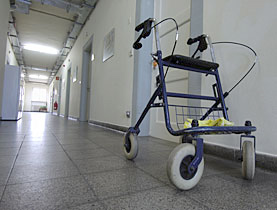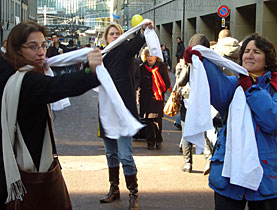Risk assessment “key” to treating sex offenders

The murder of a 16-year-old girl has dominated the Swiss papers this week – and the revelation that her alleged killer was a repeat offender has fuelled public anger.
Forensic psychiatrist Dr Frank Urbaniok, an expert in offence-oriented therapy who works for canton Zurich’s justice department, explains to swissinfo the system for treating violent and sex offenders.
In the current case, people want to know why the self-confessed murderer, a 25-year-old known only as Daniel H., wasn’t in prison after trying to kill another young woman in 2003.
Instead he spent four years in a rehabilitation centre where young adult offenders receive both psychotherapy and job training, and learn how to fit in better in society. On his release last August he was supposed to follow a course of treatment to break his drug habit, but stopped doing so.
According to newspaper reports, he was known to be dangerous when under the influence of drugs and alcohol. H. apparently lured Lucie Trezzini to his flat, by telling her he was looking for girls to model jewellery. Once there, he killed her.
swissinfo: The papers are saying there are a lot of violent offenders running around free. How is that possible?
Frank Urbaniok: People need to realise that practically all violent and sex offenders are released at some point – it’s something that not everyone is sufficiently aware of.
swissinfo: Does the system for dealing with violent offenders actually work?
F.U.: With modern methods and if you have properly trained people, you can make a very reliable risk assessment. In the Lucie case it doesn’t seem to have been the assessment that was the problem, but what maybe happened afterwards. However, I do not have sufficient information to give a final opinion on this.
It can be difficult for probation officers because they often have many clients. They may have a problem with five, ten or 20 of them at any given time, who don’t stick to the conditions, or who consume drugs, and it is not always obvious to decide in which cases to intervene and how quickly.
swissinfo: Is there a problem with financing the service?
F.U.: There shouldn’t be. The key is always the risk assessment. You have to know the risk a certain person poses in order to decide which measures should be taken. It is important to concentrate on the ones [violent offenders] found to be particularly dangerous, and for them lack of time and resources shouldn’t come into it. These particularly dangerous ones shouldn’t get swamped amidst all the others.
swissinfo: Are there enough psychiatrists to deal with these offenders?
F.U.: The situation has greatly improved in the past ten years. But such specialists don’t come from nowhere. After their basic medical training they have to be trained in forensic psychiatry, and then it takes three or four years on top of that – and they must have the talent for it as well.
Forensic psychiatry isn’t everyone’s cup of tea. It’s very tough. The strategy is to have people who are fully committed to being forensic psychiatrists, who are well trained, who are aware of the difficulties and are ready to take responsibility for what they do.
swissinfo: Offenders who accept rehabilitation are supposed to want to develop themselves. But don’t many simply see it as a chance to get off lightly?
F.U.: It depends. There are some who are really not interested in self-development. But that’s what the psychiatrist has to determine. If we feel they are not serious about it, that calls for a rethink and a different decision.
swissinfo: How easy is it to decide that that is the case?
F.U.: It’s relatively easy to determine as long as you have created the right conditions. If you just meet your client one-to-one once a week, you can’t tell very well if he is play acting.
We put a lot of emphasis on group therapy. Perhaps you have eight sex offenders sitting together, and having to talk about what they have done. “Do I have fantasies?” “How did I get to the point of committing the crime?” In the long run it’s difficult to play act in these circumstances. The professionals or the other offenders will soon notice if someone is trying to pull a fast one.
swissinfo: What role does the media play in your work?
F.U.: I always say you must be well acquainted with the case before you pass judgement but today the public and the media are quick to say: “They were obviously wrong.” Then politicians come along with all sorts of proposals.
On the other hand, I think it’s important for people to take an interest in these matters and examine them.
So we have both sides. Knee-jerk judgements, the emotional attempt to find scapegoats is the wrong way. But I think it is a good thing to go into these cases and analyse and explain them.
swissinfo: And do the media in fact examine and explain them?
F.U.: Often they are more interested in sensation and scandal and there is not a lot of sophisticated comment. Success stories are not interesting.
swissinfo-interview: Julia Slater
Authorities in canton Aargau announced on Thursday, March 12, that they were opening an investigation into the conditions surrounding the alleged murder’s release from a rehabilitation centre in August, 2008. Dani H. had been in the facility for four years after nearly beating another woman to death in 2003. The investigation will be led by an independent expert. Kurt Wernli, a member of the cantonal government, said that officials in charge of the case acted “correctly and in an appropriate matter”.
Swiss courts can send young offenders to rehabilitation centres rather than to prison.
These centres are designed for young adults aged between 18 and 25 when the offence is committed.
They are for people with personality disorders, in cases where the disorder has led to the offence.
They must show a desire for self-development.
The programme lasts a maximum of four years and the offender cannot stay once he or she has reached 30.
Offenders learn a trade, and are helped with practical problems of integrating into normal life.
In addition, they undergo psychotherapy to help them change their destructive behaviour patterns and take responsibility for their own actions.
14,045 youths (79.5% boys) were convicted of crimes in 2006, according to the Federal Statistics Office. That was up about 2,000 from 1999.
Convictions for driving offences, attacks against people and property-related crimes have been increasing since 1999, while drug-related offences have dropped.
Police figures suggest violent youth crimes have doubled in the past eight years, but researchers say they view the numbers with caution.
Studies in Switzerland, Germany, the Netherlands and Sweden suggest people are reporting more crimes than before.

In compliance with the JTI standards
More: SWI swissinfo.ch certified by the Journalism Trust Initiative











You can find an overview of ongoing debates with our journalists here . Please join us!
If you want to start a conversation about a topic raised in this article or want to report factual errors, email us at english@swissinfo.ch.